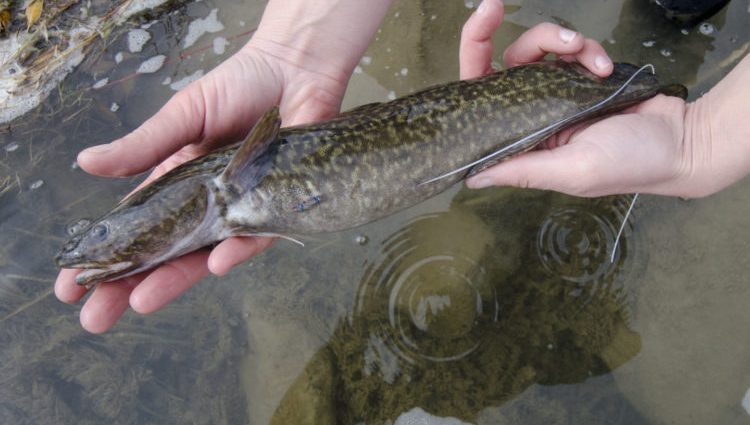Садржај
Perhaps the most interesting fish that lives in the fresh waters of the country is burbot. Its behavior and lifestyle are as different as possible from the usual inhabitants of the water area. Burbot is the closest freshwater relative of cod, whose nature is to live in the northern seas. Burbot, like cod, feels great in cold water, so the peak of its activity occurs at the end of autumn – winter.
When and where to catch burbot
The burbot does not have scales, it has a slimy elongated body and a mustache characteristic of the cod family at the lower jaw. The purpose of the mustache is in the tactile sensation of the bottom and the search for food. The catfish is endowed with a similar organ; it has several whiskers on the outside of the lower jaw.
Burbot lives in burrows under steep banks, rocky rubble, snags and other “impassable” places. In summer, the fish stays in their shelters, warm weather forces them to be at a depth with a moderate current, where the water is more or less cool. With the onset of the first cold weather, the burbot becomes active and begins to feed. You can catch a predator from September, if the atmospheric front and daily temperature conditions allow.
Interestingly, the weight of the fish depends on its habitat. The closer to the southern part of the country, the smaller the predator is hooked. In the northern regions, you can count on an excellent trophy much more often.
The worse the weather, the more active the burbot. Experienced anglers claim that the predator is perfectly caught at night in a hurricane. Although it’s uncomfortable to be on the pond on such days, fishing comes out excellent.

content.govdelivery.com
As late autumn sets in, the appetite of the fish also increases. Burbot is considered a predator, although his way of feeding is different. Of course, there are cases of catching freshwater cod on spinning or live bait, but most often the fish picks up food from the bottom.
The diet of the spotted inhabitant of fresh rivers includes:
- crayfish and other crustaceans;
- juveniles and eggs of other fish species;
- frogs, leeches, swimming beetles;
- remains of fish and aquatic animals;
- barley, mussels and other shellfish.
You can go fishing before dawn. In autumn, burbot is caught around the clock, if the weather is right outside. Strong winds and rain are a great sign that it’s time to go fishing. Burbot is more common in rivers than in confined waters, but ponds and lakes with many underwater sources may be an exception. Often burbot comes across in reservoirs, he prefers not to leave the old riverbed, where a decent depth is formed and there is a constant current.
It is also good to catch burbot during the freezing period. The winter donka is a small ice fishing rod equipped with a large jig. The nozzle, as a rule, is sprat, liver or fish slices.
How to choose a place for fishing on the donk
Fishing burbot is complicated not only by weather conditions, but also by the habitat of the fish. It is worth remembering that the fish does not leave the same zone throughout their lives. If burbot is caught in a certain section of the river, then there is no point in looking for it somewhere else.
Promising places for fishing on the donk:
- driftwood with a depth of 2,5 m;
- rocky dumps, shell rocks;
- pools and pits with a reverse flow;
- steep banks with a depth of 3 m;
- fallen trees, logs sticking out of the water.
Freshwater cod occupies sections of the river with plenty of cover. Although burbot is not considered a schooling fish, it still keeps in large clusters.

fishelovka.com
There are several factors to consider when choosing a fishing spot:
- доступност базе хране;
- current strength and depth;
- drops, falls, uneven bottom;
- stones, driftwood and the number of hooks;
- man-made buildings, bridges, piles, scaffolds.
You need to check a new place with a donkey for several days, randomly selected during a certain period. It happens that the fish refuses to bite during the day, but comes out to feed after dark. This suggests that it is not necessary to collect gear in advance.
For donk fishing, a place with a good approach to the water is suitable, however, such zones are very rare in sections of rivers where burbot is found. As a rule, the coast is steep, a fallen tree may lie upstream or downstream, so you need to carefully throw the tackle.
You should not place the zakidki close to each other. Practice shows that the burbot who grabbed the nozzle will not let it go, but will sit on the hook until the angler checks the tackle. In addition, the bite is not always visible, so the donkeys need to be rechecked every 40-60 minutes.
When arranging snacks from the shore, you should try to cover as many different places as possible. This will help to calculate where the burbot is currently holding. It is important to change not only the distance from the coast, but also the depth, the type of bottom, the proximity of blockages and possible shelters. On a clean bottom, fish are extremely rare, so you should try to place gear in such a way as to avoid hooking, but also to be close to it.
After a bite, the fish rushes to the shelter, so the often missed approach of burbot ends with a break in the tackle.
Do-it-yourself donka
There are two types of bottom tackle for catching freshwater cod: rod and hand. In the first case, a telescopic or plug blank is used for casting and fighting. It allows you to make more accurate and far casting, as well as raise fish on a steep bank. A hand donk or a thrower is a reel on which the equipment is wound. Its advantages are in its small size. When fishing on foot, snacks are much more convenient to transport because they are more compact.
When placing gear, you must remember about their permitted number per angler. As a rule, it should not exceed 5 pieces. On private ponds, this amount is negotiated by the local administration.
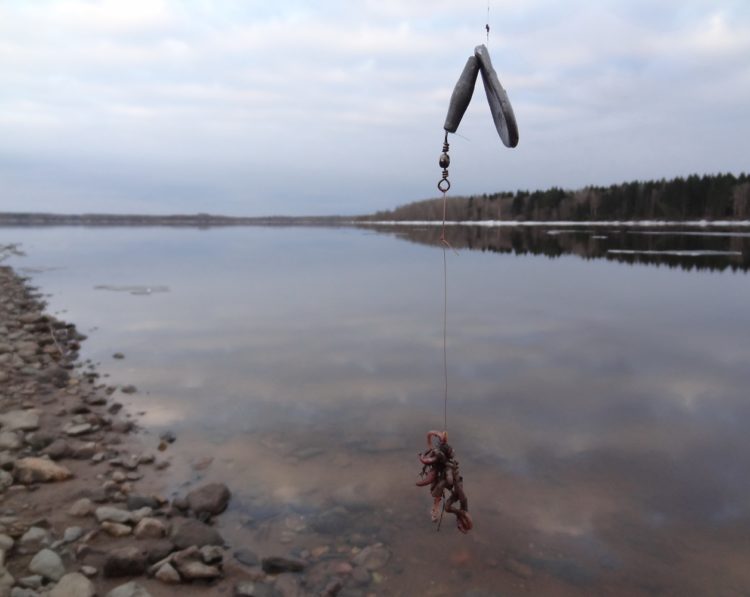
catcher.fish
Donka on burbot in autumn has a simple structure. The more uncomplicated the tackle, the higher the chances of a bite. A large number of elements in the installation not only complicate its production, but also negatively affect the bite.
Before you make a snap, you need to prepare everything you need:
- main fishing line with a cross section of 0,35 mm;
- lead material;
- оловни синкер;
- кука са дугачком дршком.
For different fishing conditions, the variation of equipment elements may differ. A thick main line with a soft structure allows you to pull the tackle from a dead hold. Most often, burbot is taken out “in an impudent manner”, because it lives in very “strong” places.
For muddy bottoms, flat bottom weights are recommended. They cling to the soft structure of the bottom in the best way. On sandy soils, sinkers with ribs or in the form of a mace are used. The protruding parts do not allow the montage to jump off the perspective place. The stronger the flow of water, the more heavy the donk should be for burbot.
Since the fish often take the bait in the throat, single hooks with a long forearm are used for fishing, which are easier to pull out of the predator’s wide mouth. The distance between the hook and the sinker is 0,5 m, it can be increased depending on the bite. If the bite of the fish is not visible, then the leash is shortened, if the burbot takes it, but comes off, it is lengthened.
Only one hook is used per hook. An increase in the number of lures will be accompanied by hooks, and fishing will go in the wrong direction.
To make a donkey with your own hands, you need:
- Pick up a reel with a pointed end, which will be inserted into the ground. For fishing, strong structures are used that are not blown away by the current or when biting large fish.
- Wind up the line. Monofilament should be changed every 1-2 seasons. The fact is that nylon dries out over time and becomes less elastic and more brittle.
- Attach a sliding sinker to the main line and tie a swivel with a carabiner. Most often, a sliding version of the equipment is used, since it better conveys the bite of a predator. On the other hand, a stationary sinker cuts the fish by itself due to the stop created by the weight of the lead.
- Next comes the leash, its diameter should be slightly thinner than the main line, so that when it breaks, part of the equipment returns to the angler. If the leash is thicker, then it is impossible to predict exactly where the tackle will break. In this case, the main line will quickly run out and you will have to wind new nylon.
- The rigid fluorocarbon leader does not tangle, so the rig is always in working order. With Fluor, you do not need to use anti-twist in the form of a tube or nylon pigtail.
Bottom tackle with the use of a rod is practically no different from snacks. Anglers use the same rigs with sliding or fixed weights.
Effective Rig Variations
Despite the existence of the classic rig, which has been used by anglers for decades, many burbot anglers have begun to create their own rigs.
Ретрацтор Леасх
This type of tackle showed itself perfectly with a weak activity of the predator. The fact is that a retractable leash is a variant of a spaced equipment, where there is a V-shaped piece of fishing line between the hook and the sinker. The loose nylon transfers the bite to the rod without catching the lead, so the fish feel no resistance.
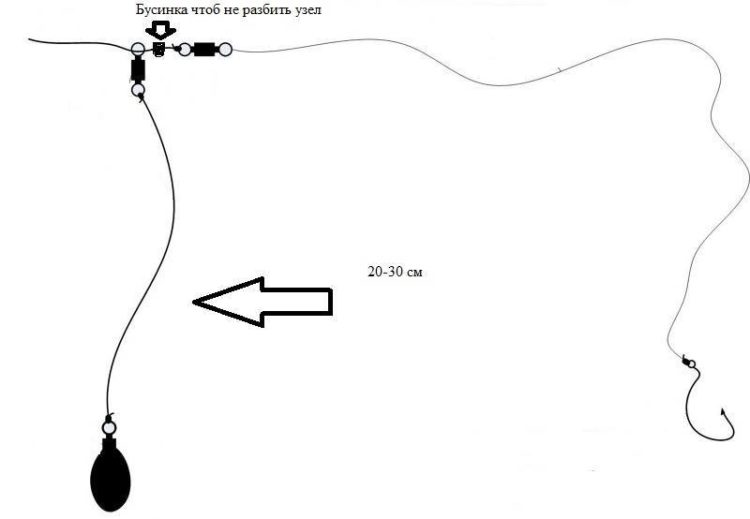
ацтивефисхер.нет
For rigging, you will need a sinker, a triple swivel and a hook. There is a variation without a swivel, and many anglers use it. The first step is to tie the sinker. A stationary lead with an eye at the top is best. Its type is used depending on the depth and strength of the current. Next, measure 0,5 m from the sinker and make a loop on the main fishing line, to which a meter-long leash will be attached.
This kind of installation is good when fishing with a live bait. A long leash allows a fish or a small frog to move freely, attracting a predator.
ринг
The name of the installation of donkeys for fishing was due to the use of lead in the form of a ring. It is worth noting that such a sinker is better than other forms of holding on to a strong current and a muddy bottom.
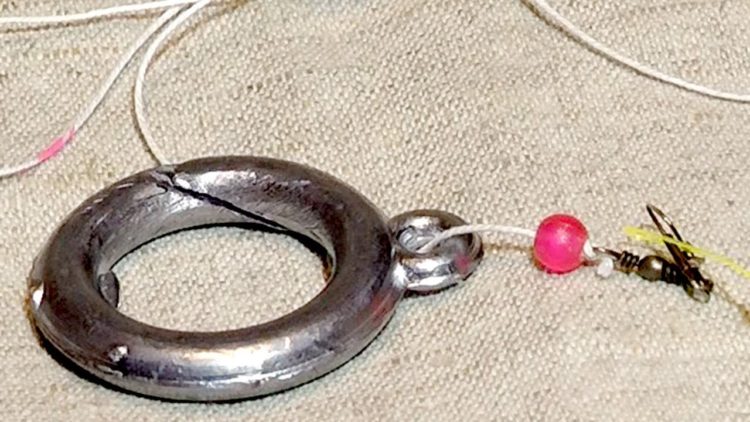
и.итимг.цом
They catch on the ring in more or less clean places, so the equipment has several hooks.
Installation is done as follows:
- Tie the ring to the free end of the main line.
- Loops are tied at a distance of 40-60 cm.
- It is undesirable to use more than three hooks, the optimal value is 2 baits.
- Short leashes are attached to the loops, up to 10 cm long.
- So that the hooks do not get confused, they are mounted with a nylon pigtail.
In addition, there is a drop-shot type equipment used in spinning fishing. Instead of loops on the main fishing line, hooks are knitted with a distance of 40-6 cm from each other, and at the end a ring sinker is mounted.
Experienced anglers use large nuts instead of buying specialized rings. As a rule, this detail does not affect the final result in any way.
Mounting with feeder
Some freshwater cod hunters resort to baiting the fishing area. To do this, they use different kinds of feeders. Feeder models allow you to raise tackle to the surface when reeling in, which provides fewer hooks. Such a feeder can be used instead of a sinker or together with it.
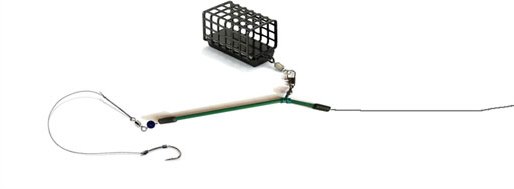
marlin61.ru
There are also variations with the use of a spring, which are best suited for fishing in strong currents. The fact is that the food is washed out of the spring much more slowly, attracting the fish to the nozzle.
Installation looks simple: a feeder is placed on the main line, then a sliding bead and a swivel are installed. The bead prevents the load from breaking the knot, so its presence is mandatory. A half-meter leash with a hook departs from the swivel.
In the version with a feeder feeder, everything is the same, only an anti-twist tube is placed on the main line, to which the feeder is fastened by a carabiner.
Bait and nozzles for catching burbot on the bottom
For fishing with the use of feeders, loose earth from molehills is used as a basis. Add moisture to it carefully so that the soil can be formed into balls that would break on the water. The role of the earth in bait is to make it heavier. The soil allows you to lower the edible component to the bottom, where the predator hunts.
It is worth noting that the use of bait mix often affects fishing in a positive way.

ацтивефисхер.нет
Shellfish, chopped worms, offal, pieces of fish and meat are used as an edible component. If the donkeys are located nearby, then you can feed manually. To do this, you need to mix the edible mixture with the soil, make balls and throw them a little upstream. The flow of water will deliver the balls directly to the rig, the main thing is not to miss the distance.
In the role of bait for burbot use:
- a bunch of creeps, earth and red worms;
- meat of mussels and barley;
- cancer neck;
- live bait, frog;
- carcass or slicing of fish;
- Пилећа џигерица.
The fish is perfectly caught on any meat trimmings, but a live bait attracts the attention of a predator better. Also, dry and liquid blood, meat attractants and amino acids that increase appetite are added to the bait and nozzle.
Before casting, the baited hook is dipped in blood or a suitable dip with the smell of meat, shrimp, shellfish or crab. In the course of fishing, you can experiment with attractants, finding out the most working option.
Burbot perfectly takes on the larva of the cockchafer. In October-November, it can be obtained under the bark of half-living trees and stumps, in the ground near water bodies. The larva is stored simply in a jar of soil in the refrigerator. With proper storage, it is possible to harvest the creep and larva of the cockchafer in large volumes for the whole autumn and winter.
To prevent the bait from moving off the hook (relevant for creeps, live larvae and chicken liver), use a silicone stopper that holds the bait in its original position. The stopper does not affect the percentage of bites in any way. After each change of bait, the stopper is updated. As stoppers, you can use cut pieces of silicone tubes or a nipple.










